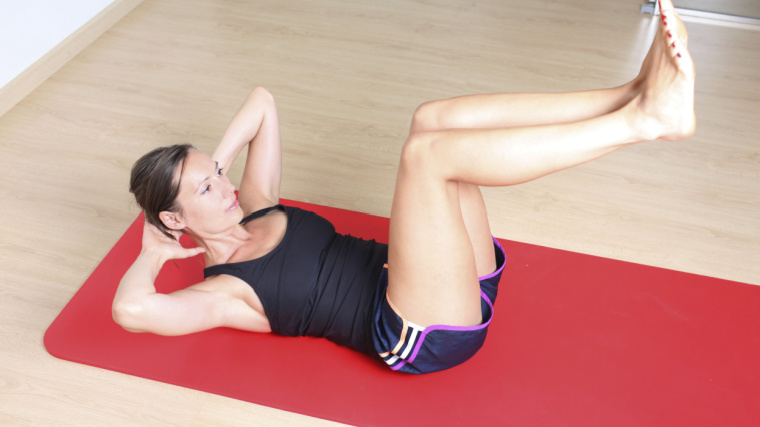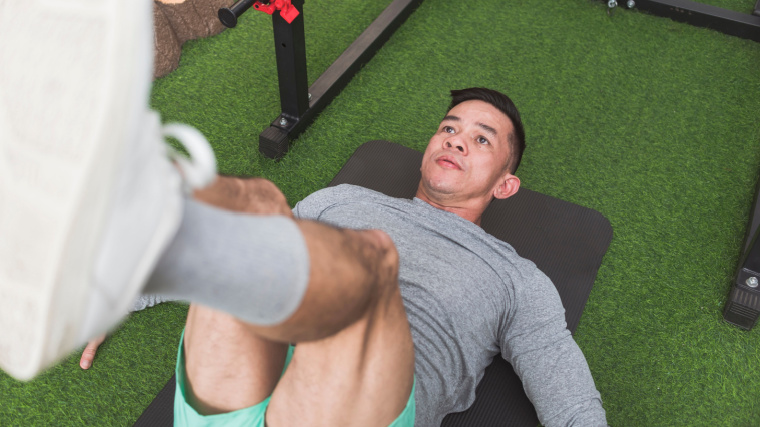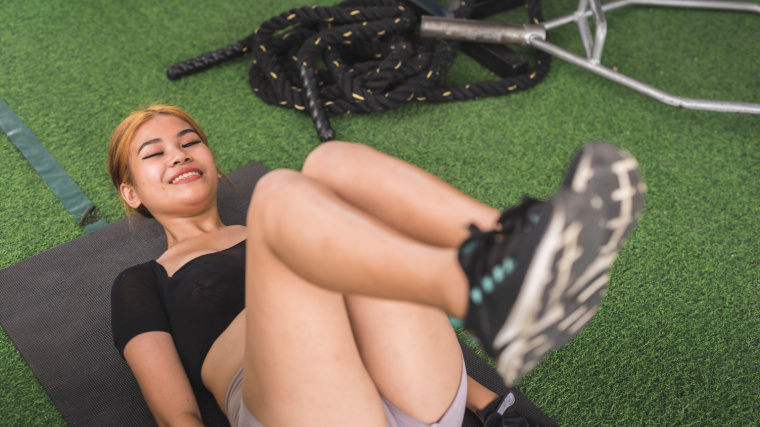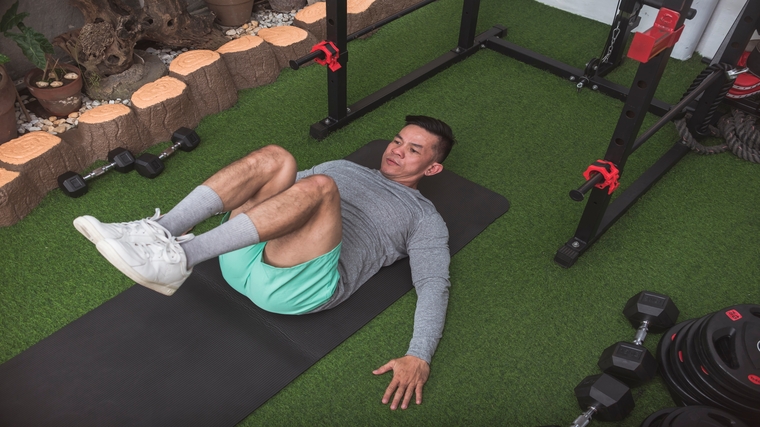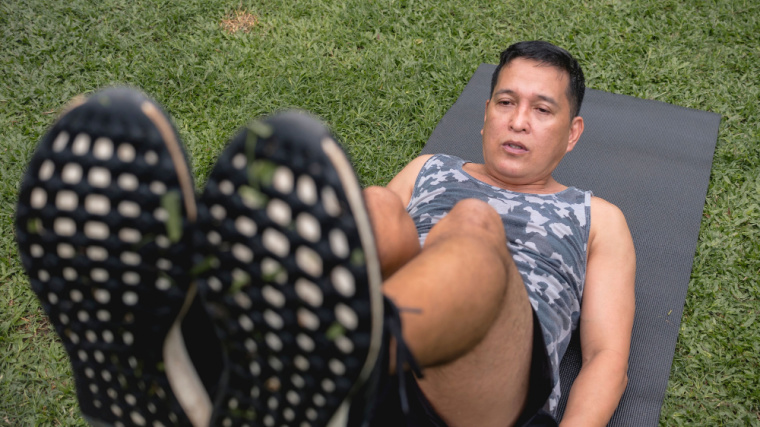The reverse crunch is a very popular core exercise — and with good reason. It is a great beginner-friendly core move that can easily cater to more advanced athletes, too. While mainly targeting the abdominal muscles (what you think of when you visualize a six-pack), this move also targets the obliques and hip flexors.
Regardless of your training goal, the reverse crunch can likely help get you there. It’ll help you build a stronger core, increase lower body control, and give your midsection that boost of endurance you need to power through tough lifting sessions. Here, you’ll learn everything you need to know about the reverse crunch so you can best maximize your ab strength.
- How to Do Reverse Crunches
- Reverse Crunch Sets and Reps
- Common Reverse Crunch Mistakes
- Reverse Crunch Variations
- Reverse Crunch Alternatives
- Muscles Worked by the Reverse Crunch
- Benefits of the Reverse Crunch
- Who Should Do the Reverse Crunch
- Frequently Asked Questions
How to Do the Reverse Crunch
The reverse crunch can be performed anywhere — from the comfort of your own home, your local gym, or even in the great outdoors if you like training outside.
Step 1 — Set Up
Lie down on a flat surface with your back on the ground and your eyes facing toward the ceiling. Position your arms straight by the sides of your body. Push your palms into the ground.
Lift your lower body off the ground and bend your knees, so your legs form an upside-down “L.” Make sure that when you are in this position, your lower back is flat on the floor. This is the starting position for the reverse crunch.
Coach’s Tip: If you have a hard time flattening your lower back, you can keep your hands underneath your tailbone. This will help you tuck your pelvis under and flatten your lower back.
Step 2 — Crunch Your Abs
Crunch through your abdominal muscles to bring your knees to your chest as you roll your lower back off the floor. Exhale as you bring your thighs up and back toward your chest.
Make sure that you keep your knee angle consistent at 90 degrees throughout the whole movement.
Coach’s Tip: To avoid making this ab move too much of a hip flexor exercise, use your core to curl your hips off the floor toward your chest instead of initiating the movement with your legs.
Step 3 — Return Your Legs to the Start Position
Inhale as you slowly return your lower back to the floor in a controlled manner. Flatten your back gradually down to your tailbone. Stop when you reach your starting position.
Coach’s Tip: Your whole mid-back and tailbone should not touch the floor simultaneously. Try to think about rolling back down like rolling out a rug.
Reverse Crunch Sets and Reps
Your rep ranges for the reverse crunch aren’t going to look like they do for your average barbell exercise. Your core is accustomed to handling a lot of work since it’s involved in pretty much every compound exercise you do. As such, you’ll need to hit your core hard (and with a lot of high-quality reps) to stimulate growth and strength.
- For Muscle Mass: Aim for three to four sets of eight to 20 repetitions.
- For Strength: Perform three to four sets of six to 10 repetitions, leaving about two to three repetitions in reserve. If you need to load the reverse crunch to achieve this, you can attach ankle weights or a cable machine handle to your ankles to increase resistance.
- For Endurance: Do two to three sets of 15 to 30 slow repetitions.
Common Reverse Crunch Mistakes
As simple as this exercise seems, it is not completely foolproof. There are some common mistakes that you definitely need to watch out for in order to make the most out of this exercise.
Not Lifting Your Back
Your abdominal muscles act as a flexor of your spine. If you do not lift your back off the floor and you end up only hinging at your hips, you are not engaging your abdominals enough. You are consequently only training your hip flexors instead.
To make sure you’re fully engaging your abs instead of just yanking through your hip flexors, focus on making sure the movement comes from crunching your abs together. Actively curl your lower back away from the ground to help this happen.
Not Allowing Your Back to Roll Back Down
By allowing your back to roll back down rather than letting your whole back return to the ground as a single unit, you allow your abdominals to lengthen in the eccentric portion of the exercise, which is important for enhancing muscle growth.
Avoid letting your back just flop back down as one unit. Really concentrate on returning to the ground vertebrae by vertebrae, moving slowly and with control.
Tucking Your Knees
You do not want to tuck your knees too far back toward yourself when you perform the reverse crunch. This is because when you tuck your knees back too much you end up bringing your whole body weight onto your upper back and then towards your neck. You don’t want to lose control at the top of the lift and risk the alignment of your neck.
Instead, maintain a 90-degree angle with your knees at all times throughout the exercise. This will help protect your neck and keep the emphasis on your core.
Reverse Crunch Variations
Reverse crunch variations are helpful for customizing the exercise to your preference and experience level.
Weighted Reverse Crunch
The way you perform the weighted reverse crunch is to hold onto a weight with your arms vertically in the air. This can help you increase the activation of your upper abdominal and serratus anterior muscles.
You can use a dumbbell, medicine ball, or small weight plate. Hold your chosen weight above your shoulders and focus on reaching toward the sky as high as possible. Aim for your shoulder blades to come off the floor slightly so that your ribcage flattens.
Decline Reverse Crunch
The decline reverse crunch leverages the use of a decline weight bench or sit-up bench to increase how gravity acts upon your abdominals. All you need is a training bench set to a 30-45 degree incline.
Lie down on the bench with your head at the higher end of the bench and grab onto the top of the bench with your arms above your head. You can start with your knees at 90 degrees or you can straighten and lower your legs to make it harder.
Banded Reverse Crunch
The banded reverse crunch increases the resistance to the main muscles that you work through when you perform this exercise.
You can attach a resistance band to a fixed anchor and around your ankles. Make sure that at the beginning of the exercise, the band is providing tension. When you execute the move, perform it just like a regular reverse crunch. With the help of the resistance band, the resistance on your abdominal muscles will increase as you near the top of each rep.
Reverse Crunch Alternatives
If you don’t want to get on the ground to give your abs a solid workout, you don’t have to. Here are three reverse crunch alternatives, two of which you can perform without lying down.
Toe Touch
The toe touch is similar to the reverse crunch and is as accessible as performing a reverse crunch in the sense that all you need is flat ground and your own body weight.
To perform the toe touch, you’ll straighten your legs and hold them vertically in the air. With each rep, reach your arms toward your toes, then return your upper torso back down to the floor.
Roman Chair Leg Raise
Roman chair leg raises, also known as captain’s chair leg raises, are a lower abdominal exercise that uses a popular piece of equipment found in many commercial gyms.
Brace yourself onto the Roman chair by your elbows and forearms. You execute the exercise by raising your legs upwards as you crunch your abdominals.
Hanging Leg Raise
The hanging leg raise is similar to the Roman chair leg raise, but it is performed with you holding onto a pull-up bar.
Perform this move by raising your legs upwards and crunching your abdominals while in a steady dead hang position. You can bend your knees if you need to, but you can keep your legs straight if you are more advanced.
Muscles Worked by the Reverse Crunch
The reverse crunch is exclusively a core exercise. Here are the three parts of your core that the reverse crunch works most.
Abdominals
The abdominals consist of the rectus abdominis and the transversus abdominis. They both attach from your rib cage to your pelvis. They facilitate flexion and rotation at the torso and are engaged very directly here.
Obliques
Your obliques are the core muscles on the sides of your torso and consist of your internal and external obliques. They facilitate flexion, lateral flexion, and rotation at the torso. You’ll use them to keep yourself centered throughout this movement, preventing movement from side to side.
Hip Flexors
Your hip flexors consist of the iliacus and psoas muscles. They attach from your lower back and pelvis to your thigh bone. They facilitate rotation as well as flexion at the hip.
As such, it’s normal for them to be somewhat involved in the reverse crunch. Just make sure they don’t take over the exercise by concentrating on initiating each movement with your abs, not your legs.
Benefits of the Reverse Crunch
The reverse crunch is super effective for developing your physique for aesthetics as well as for physical performance. Here are some of the benefits that you will reap from this core exercise.
Increase Ab Muscle Growth
Though it might seem humble, the reverse crunch can help stimulate hypertrophy in your abdominal muscles. The key thing to remember when training for muscle mass is allowing your abs to stretch and maximizing that range of motion with each rep. Move slowly and deliberately, making sure the real effort is coming from your core.
Improve Bracing Strength
Performing the reverse crunch can help develop the same muscle groups that are necessary for developing a strong brace for compound exercises such as squats and deadlifts. Your core may quickly become a weak link too early if you don’t train your abs directly.
Adding moves like the reverse crunch into your repertoire helps keep your core in tip-top shape to support strong, heavier barbell lifts. Without direct core training, you’ll be leaking a lot of potential out of your core bracing.
Build Balanced Core Strength
If you have a very developed lower back, performing the reverse crunch can be a great way to balance out your core area. This is because the abdominal muscles are opposite and antagonistic to the lower back extensors.
For example, all those deadlifts involve a lot of heavy recruitment from your lower back. But if the front part of your body — your abdominals — aren’t able to keep up, you run the risk of developing imbalances that can seriously throw you off your game. Combat this by adding ab-strengthening moves like the reverse crunch into your routine.
Improved Core Endurance
Reverse crunches can develop your muscular endurance around your core area, which may have a positive carryover to other strength sports. You’ll need a high work capacity in your core whether you’re long-distance running or preparing to perform a dreaded 20-rep squat set.
Who Should Do the Reverse Crunch
As the reverse crunch comes with various benefits, it also means that the reverse crunch can be suitable for various lifting demographics.
Beginners
If you are new to exercise or new to going to the gym, the reverse crunch is a great way to kick off your core training routine. The reason is that you can perform the reverse crunch anywhere — whether in your home gym, a hotel room, or at your local CrossFit box. You can see improvements easily in your workouts by performing more repetitions over time.
Strength Athletes
Reverse crunches target your abdominal and hip flexor muscles. These are important for managing your hip and back posture in big compound movements that may be seen in powerlifting, weightlifting, or even strongman events.
Adding core accessory exercises into your strength-focused routine will keep your lifts looking strong.
Bodybuilders
Physique athletes are often looking for ways to not just train a whole muscle group, but also to target and isolate regions of a muscle to best sculpt their physique. As such, bodybuilders can easily use this as an isolation exercise to target the lower abdominal region.
The Crunch, Reversed
The reverse crunch is an entry-level exercise, but that does not mean that it should only be used by beginners. Regardless of your experience level, you can modify your technique and vary it up to improve your gains long term. Progression does not just exist within the confines of sets and reps — don’t be afraid to use the reverse crunch creatively to chase your ab goals.
FAQs
You might still have questions about this exercise. If so, you’re not alone. Here are some questions that get asked about the reverse crunch all the time.
Is the reverse crunch good for belly fat?
Much to the chagrin of many lifters, spot fat reduction simply doesn’t work. As such, the reverse crunch cannot necessarily target belly fat. To reduce belly fat, you need to be adopting a consistent routine of resistance exercise and maintaining a caloric deficit in your nutrition plan. Maintaining consistency with those habits may eventually help reduce belly fat if that’s your goal.
Which is better: the crunch or the reverse crunch?
That depends on your goals. Arguably, the crunch is better for isolating the abdominal muscles, whereas the reverse crunch also involves hip flexor muscles. You may feel the reverse crunch in your lower abdominal fibers more and feel the crunch in your upper abdominal fibers more. Choose your fighter according to your needs.
Do reverse crunches make your waist smaller?
The reverse crunch does not necessarily make your waist smaller. There are factors of body type and bone structure to consider regarding the size of your waist. But if you want to control the variables you can, you’ll want to pay attention to strength training and a steady nutritional plan, as well as maximize your sleep and minimize your stress as much as possible.
Featured Image: MDV Edwards / Shutterstock
